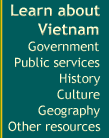











|
Government
National Assembly
Chairman Nguyen Van An
The National Assembly is the highest representative organ of
the people and the highest organ of
State power of the Socialist Republic of Vietnam.
The National Assembly is the only organ with constitutional
and legislative powers.
The National Assembly shall decide the fundamental domestic
and foreign policies,the
socio-economic tasks, the country's national - defence and security
issues, the essential principles
governing the organization and activity of the State machinery, the social
relations and the activities
of the citizen.
The National Assembly shall exercise supreme control over
all activities of the State.
The National Assembly has the following obligations
and powers:
- * To make and amend the Constitution;to make and amend laws; to work
out a programme
for making laws and decree-laws;
-
- * To exercise supreme control over conformity to the Constitution, the
law and the
resolutions of the National Assembly; to examine the reports of the
country's President, the
Standing Committee of the National Assembly, the Government, the Supreme
People's
Court, the Supreme People's Office of Procuracy.
-
- * To decide the country's plan for socio - economic development;
-
- * To decide the national financial and monetary policies; to decide
the draft State budget and
budgetary appropriations; to approve the accounts of the State budget; to
establish, change,
or abolish taxes;
-
- * To decide the nationalities policy of the State;
-
- * To regulate the organization and activity of the National Assembly,
the country's President,
the Government, the People's Court,the People's Office of Procuracy and
the local
administrations.
-
- * To elect, release from duty, remove from office the country's
President and
Vice-President, the Chairman of the National Assembly, the Vice - Chairman
and members
of the Standing Committee of the National Assembly, the Prime Minister,
the President of
the Supreme People's Court, the Head of the Supreme People's Office of
Procuracy; to
sanction the proposals of the country's President on the establishment of
the Council of
National Defence and Security ; to sanction the proposals of the Prime
Minister on the
appointment, release from duty and removal from office of the Deputy Prime
ministers,
Cabinet Ministers and other members of the Government;
-
- * To set up or suppress government ministries and government organs of
ministerial rank; to
establish, merge, divide, or adjust the boundaries of provinces and cities
under direct central
rule; to set up or disband special administrative-economic units;
-
- * To abrogate all formal written documents issued by the country's
President, the Standing
Committee of the National Assembly, the Government, the Prime Minister,
the Supreme
People's Court,and the Supreme People's Office of Procuracy, that run
counter to the
Constitution, the law, resolutions taken by the National Assembly;
-
- * To proclaim an amnesty;
-
- * To institute titles and ranks in the people's armed forces, in the
diplomatic service and
other State titles and ranks; to institute medals, badges and State
honours and distinctions;
-
- * To decide issues of war and peace; to proclaim a state of emergency
and other special
measures aimed at ensuring national defence and security;
-
- * To decide fundamental policies in external relations; to ratify or
annual international
agreements that have been signed or participated in on the proposal of the
country's
President;
-
- * To hold a referendum.
The duration of each National Assembly is five years. Two months before
the end of its tenure, a
new National Assembly shall have been elected. The electoral procedure and
the number of
members of the National Assembly shall be established by law. In special
cases, with the approval
of at least two thirds of its members, the National Assembly can either
reduce or prolong its period
of tenure. The National Assembly shall hold two sessions each year, to be
convened by its
Standing Committee.
Learn about Vietnam
Government |
Public services |
History |
Culture |
Geography |
Other resources
|
|











